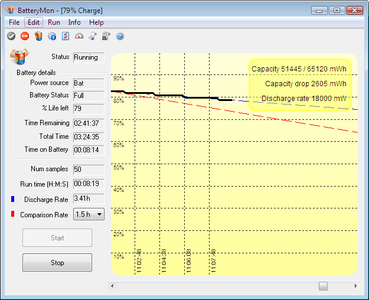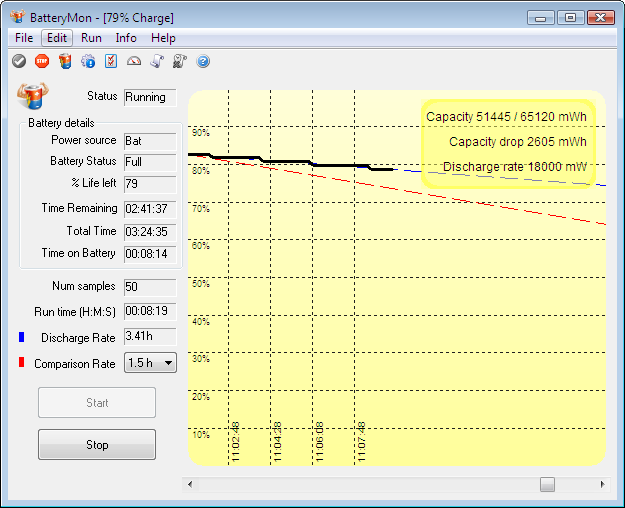PassMark BatteryMon.v2.1.1000 | 1.5 MB
BatteryMon is a battery monitoring software solution. It has been designed as an easy-to-use Windows based application that allows users to monitor the performance of laptop batteries and uninterruptible power supplies (UPS).
* Graphically see the charge / discharge rate
* Diagnose problem battery cells with detailed statistics
* Compare and measure your batteries performance with expected discharge rates
* See the critical discharge point for your batteries
* Uniquely identify battery packs for tracking purposes or system inventories
* Log the performance of a battery for later reference
* See the status of each individual battery pack, when multiple batteries are in use
Click for a larger image Click for a larger image
Batteries, given their chemical nature, are prone to wear, corrosion, leakage and outright failure due to events like short circuits and lightning strikes. Given their propensity to fail and to have decreased performance over time, it is important to be able to identify and monitor their performance. With BatteryMon, monitoring the state of your laptop battery or UPS has never been easier. BatteryMon has the following features:
* Battery charge level is graphed in real time, along with an extrapolated trend line and comparison trend line.
* A log file is maintained of the battery charge level and other statistics for later analysis.
* Configurable sample period.
* A comprehensive help file.
* Detailed system and status information about each battery installed (see below).
* An interface to BurnInTest in order to evaluate battery performance, while under load.
* Click for a larger imageMini window mode that shows multiple batteries charging/discharging status as well as life percentage, estimated running time and more (with adjustable transparency for Windows 2000 and later).
Typical users include portable computer repair centers, system integrators, server administrators who must manage UPSes and, home users wanting to test their battery or UPS.
Compatibility
Any laptop battery or UPS that complies with the Windows, Advanced Configuration and Power Interface (ACPI) specification should be able to report information to BatteryMon. Note that only Windows 98, ME, 2000 and XP support this interface. Windows95 and NT are not supported. Older PCs may also have a problem if their BIOS does not support ACPI. Some features may not be supported by some battery types, typically they will report only partial information in this case. It has been also been noted that several UPS manufacturers are not providing compliant device drivers.
Status Information
The following information is provided for each installed battery (when available, as not all batteries will support all of these features).
* Status: Indicates the current status of this particular battery. e.g., "Charging", "Discharging", "Not in use".
* Manufacturer: The name of the company that manufactures the battery pack.
* Device Name: This is usually the model number of the battery pack, as defined by the manufacturer.
* Serial number: The serial number of the device as defined by the manufacturer.
* Unique ID: An identification string, which is unique across all battery packs.
* Time remaining: A rough estimate of how much time remains before the battery is fully discharged.
* Battery Temperature: The temperature inside the battery pack.
* Date of manufacture: The date when the battery was manufactured.
* Type of use: Indicates if the batteries normal use is to provide power for normal operations or if the battery is a fail safe / backup device. (Laptop battery or UPS)
* Rechargeable: Indicates if the battery is rechargeable or not.
* Chemistry: The type of battery. Typical values are: Lead Acid, Lithium Ion, Nickel Cadmium, Nickel Metal Hydride, Nickel Zinc, Rechargeable Alkaline-Manganese.
* Design capacity: The theoretical capacity of the battery when new. Measured in milliwatts hours (mWh) for most batteries.
* Full charge capacity: The battery's current fully charged capacity. In some batteries it is possible to compare this value to the designed capacity to estimate the battery's wear.
* Alert levels: The manufacturer's suggestion of when a "Low" and "Warning" battery alert should occur.
* Bias: Some batteries reserve a small charge that is biased out of the battery's Full Charge Capacity and Current Capacity values to show "0" as the critical battery level. Critical bias is analogous to setting a fuel gauge to show "empty" when there are several liters of fuel left.
* Charge cycles: The count of the number of charge/discharge cycles the battery has experienced. This provides a means to determine the battery's wear.
* Voltage: The current battery voltage in Volts across the battery terminals.
* Charge Rate: The current rate of battery charge or discharge. For most batteries this value will be in mWh.
<a href="http://cutt.red/iemieJiw6eeJ?search=PassMark%20BatteryMon.v2.1.1000" rel="nofollow noopener" onclick="log_click('PassMark%20BatteryMon.v2.1.1000', 'cutt.red'); return true;" target="_blank" rel="nofollow noopener noreferrer"><b>Download Link</b></a>



